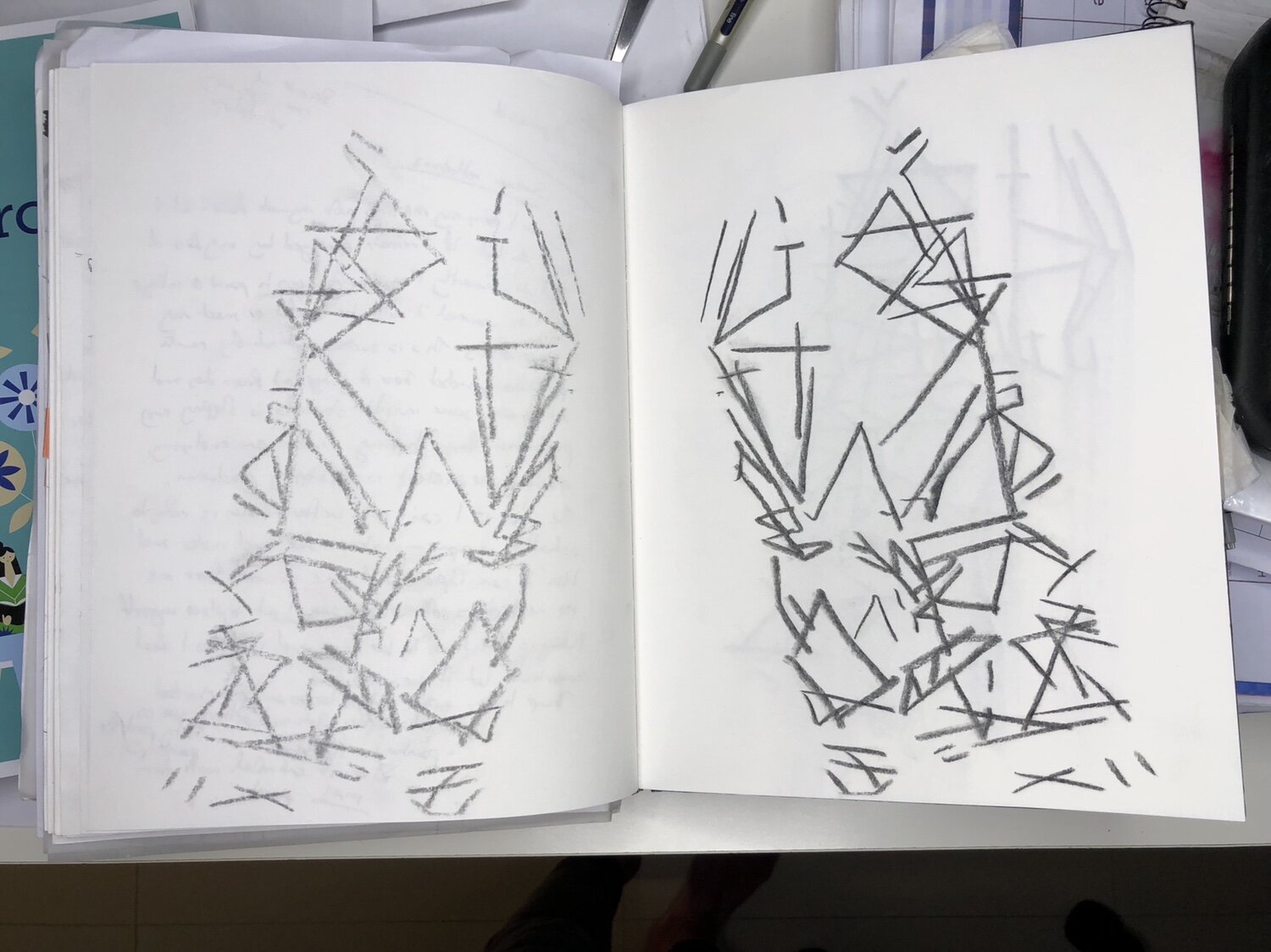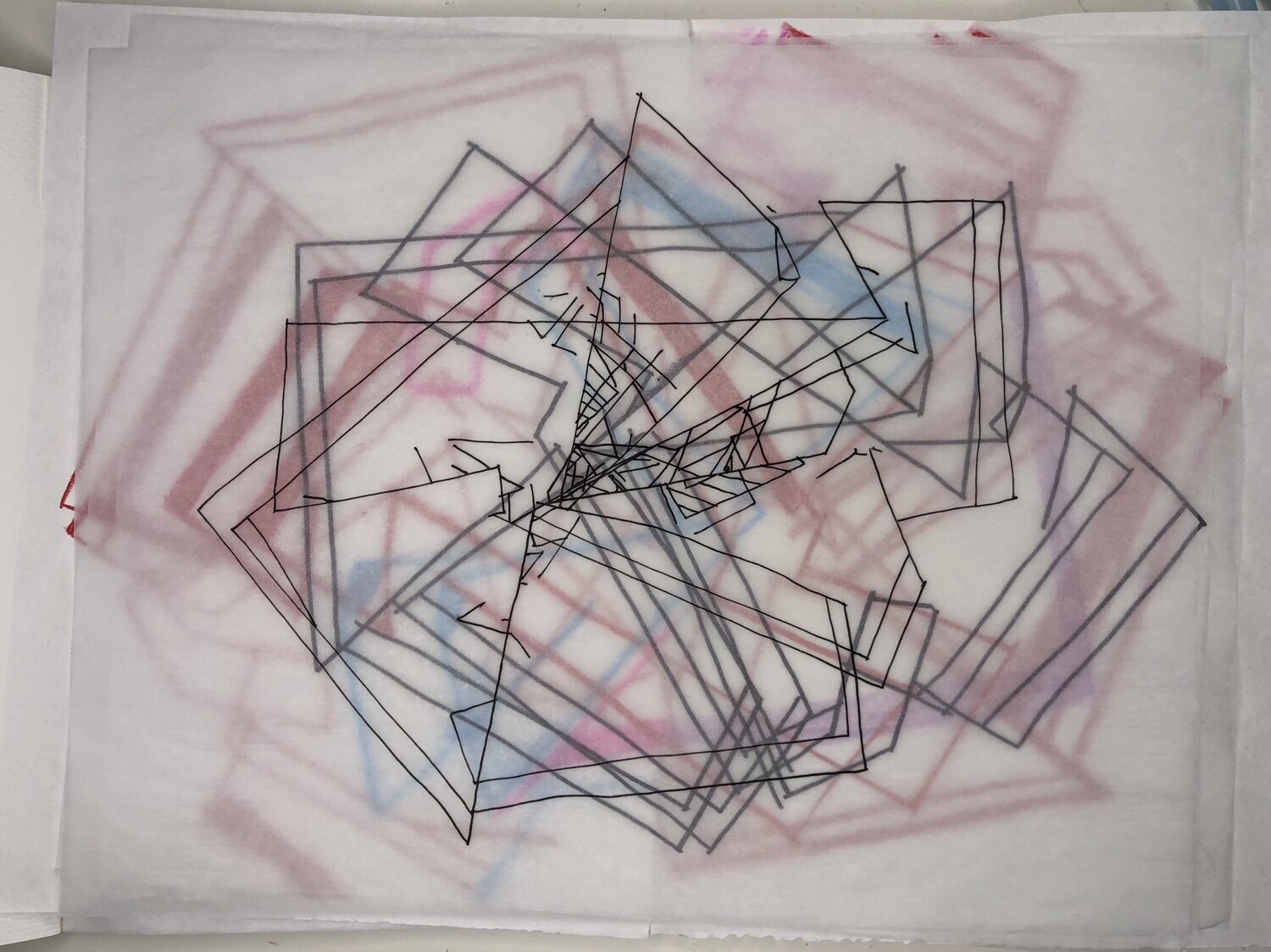

Space
Sometimes delivers
Unanticipated
Outcomes
*tea break*
sketchbook



Space
Sometimes delivers
Unanticipated
Outcomes
*tea break*
In anger I lashed out at the page, I needed the hug of the charcoal on paper - I never thought I'd hear my self say that. The abandonment of life drawing has finally caught up with me, the charcoal is haunting my thoughts, sneaking in with its lustful desires, calling and tempting me with its sensuality. My person and my business collided, I felt the anger and frustration well up - I decided to drown it in the paper and the charcoal; satisfyingly building the piles of dust on the pages as I scratched out the work.
I looked and felt like the collision was missing from the work - then I saw it - the devastation on the page, black smears tainting the pristine surface, fingerprints and smudged edges, dust and layers colliding with the white expanse. The collision happened both physically and mentally, the lines collided on the page, the thoughts collided in my head, my fingers collided with the charcoal and the page. The devastation was satisfying, the aftermath was beautiful.










In our initial meeting on September 17th, I remember saying I felt like I hadn't been very productive. However, in drawing my work together in preparation for a tutorial I realised I had actually produced a relatively good amount of work, I was being proactive but for the enjoyment, which is perhaps why I had dismissed it.




I took the time to revisit my photo collages. When I had created these pages I had always intended to paint the left page to merge the images together. My mental disposition means I get distracted, easily, really easily, and when I do drift off into my thoughts my visual focus tends to blur, meaning the visage in front of me turns into a hazy merging of lines and shapes. When this happens 'Distraction Point Two' creeps in and I veer away from my thoughts and into the patterns. These pages are an attempt to make sense of the visual clutter, the cyclic process of distraction and focus, the redefining of attention. These feel like an interpretation of the visual clutter of daily life, the distraction techniques used to keep us focused inwards.





On the pages above I returned to the process of layering. The aspect of preservation and building up feels indicative of many cities or even countries, especially where I am now. Preserving tradition and cultural ideals while building up and merging into emerging markets, opening doors for layers of society from other locations to lay foundations and develop something new for themselves and the inviting country/city.



Rough sketchbook notes: I had a couple of sit-downs both alone and with a friend and visited the goals and ideas I have in mind for the course.



These charcoal pieces were done in a frenzy, a physical manifestation of the speeding anxiety that seared through during the summer. These fragmentations that represented daily routine were metaphorically torn apart in the summer creating angst and instability. I question how I could recreate that instability and anxiety in a gallery setting without endangering the viewer.















Excitingly these works were created while leading a drawing workshop at my studio space. Evidence of collaboration of materials between myself and my guests. One member bought with her some children's watercolour crayons, they were slick in texture, almost like a lipstick and oddly satisfying to work with. I avoid colour but there was an inner rebellion against myself that urged me to explore them. I don't hate this work. The colour adds another dimension but for the use of colour to continue I need to explore the reasoning further. The psychology of colour is pertinent as I would not want misinterpretations or forced ones either.









Lastly, I am currently working in to collage. I feel like the work needs to become heavier, mirroring the change in daily routine since returning to work. Also looking at the daily routines of many families that become dense with activities, social engagements, errands etc. This process of collage is addictive and therapeutic, I envision many more of these coming into fruition. The papers are photocopies of early sketchbook pages, I would like to explore developing these into paintings, perhaps using modelling paste to build texture, something to squeezing into as we squeeze so much into each day.
Questions:
Is now the time to make work for the sake of it and allow the research I have already done to sink in? Do I keep on researching? Once you've begun researching do you ever actually stop, making that last question void?
I want to maintain the elements of repetition, that is fundamentally important to me, do I need textile techniques to do that? (embroidery)
Do I want to be labelled?...
constructivism - abstract - nonobjective - reductive art - radical art - postminimalism - formalism
Do labels matter? How can I change a label? Who gives work labels?
Reading the book '100 Artists' Manifestos', questioning whether I wish to be associated or inspired by movements/artists whose morality and ethics I question. Can you still appreciate an artwork even if you are fundamentally against the believes and concepts behind the work?
















Edits of summer collections. Visual stimulation for: Line, form, colour, contrast, space, shape.
Up scaling work from the hand-bound book overlays using a domestic printer and adobe acrobat to tile print the images. The smallest images in the photgraph below are A4, the middle image is ink on paper, a fragment drawn freehand, from the page that was then scaled up in the printing process. Using a scrap length of muslin, the cloth I favour due to its transparency, I taped to the largest image and utilised various colour markers to trace out the different fractured patterns. This is prep of density embroidery testing.
Using a scrap length of muslin, the cloth I favour due to its transparency, I taped to the largest image and utilised various colour markers to trace out the different fractured patterns. This is prep of density embroidery testing.

The books are constructed of left over photocopies. The larger one uses Japanese papers as well, sandwiched between the printer paper. Their construction is detailed in a previous post.

I have since worked in to the books by repeating my process of tracing over and through, allowing the patterns to cover both sides of the pages. The first book detailed below is 9.7 x 11.4 cm, 15 fragmented pages and is constructed of fragments of colour photocopies of sketchbook pages.








I used a black ink pen to trace the patterns on to the blank sides of the paper. I traced all that I could see through the pages, using a light box and building the density. Text is also visible from repurposed paper. I find the messy overlap and overwhelm of the pages intriguing, it has elements of construction sites, road networks, commutes or flightpaths to it.Like the invisible threads that follow us through our daily timelines, criss-crossing as we pass each other by.
The next book is 13.2 x 13.2 cm, 14 pages and constructed of monotone photocopies that had been cut previously in to rough squares for a project that lost momentum. Some are missing corners and vary in shape as they were cut for the aesthetic value of the fragmentation of the pattern.








Some of the images had also been used to trace from, so the back side is covered in pencil graphite. I liked the contrast of the rough pencil filling spaces and building the lines thicker so I continued this is variation to complete all the pages. Only the pattern on the other side is transferred in this book form. Seeing the pages open in the photographs highlights some surprising compositions, the seem to provide movement while alluding to missing parts, like the parts of a story left to the imagination.
The large piece (23 x 30.5 cm, 17 pages including covers), is a blend of printouts and Japanese papers. The images are both digital versions of the patterns and digitally enhanced enlargements of drawn patterns.








This book is a combination of the previous two. The viewable patterns are traced on each page, using different materials/colour inks (black, grey ink, graphite, varying thicknesses) creating a density on a single page that is then enhanced by the underlying pages. There is a beauty in the unexpected symmetry that appears as the pages are turned.
I feel frustrated that I am trying to move away from constraint but seem to be moving further in to it.
biographical art or a metaphor for the bigger picture? confessional - there is stress in my household and I find binding comforting, containing the chaos and creating organisation.Links to the containment of people, gathering or restricting movement, stopping the 'chaos' of globalisation, immigration, movement.

unplanned binding - not measuring, guided by eye, scrappy, unmeasured.

Taking in a new, low rise environment, without the shine of the towers I'm used to.
[gallery ids="2638,2632,2640,2637,2633,2630,2629,2628,2622,2624,2641,2642,2631,2623,2626" type="columns"]
Finding new geometries, patterns, or creating from the lack thereof.